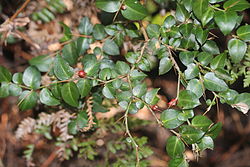| Damnacanthus | |
|---|---|
 | |
| Damnacanthus indicus | |
| Scientific classification | |
| Kingdom: | Plantae |
| Clade: | Tracheophytes |
| Clade: | Angiosperms |
| Clade: | Eudicots |
| Clade: | Asterids |
| Order: | Gentianales |
| Family: | Rubiaceae |
| Subfamily: | Rubioideae |
| Tribe: | Mitchelleae |
| Genus: | Damnacanthus C.F.Gaertn. |
| Type species | |
| Damnacanthus indicus | |
| Synonyms | |
| |
Damnacanthus is a genus of flowering plants in the family Rubiaceae. The genus is found from Assam to temperate eastern Asia. [1]